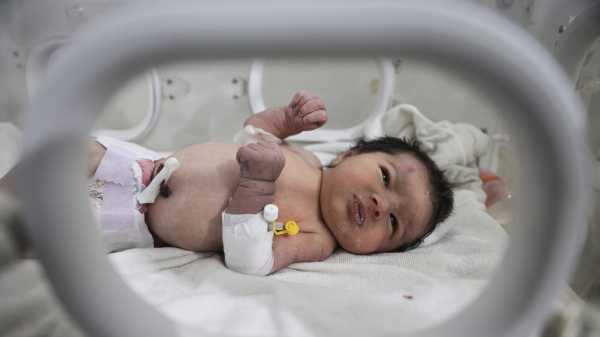
It’s a boy, they said, when he first emerged from the rubble. The video of his rescue shows a man in a red-and-white kaffiyeh bounding across the ruined stones with a limp, naked creature pressed to the front of his body. Several seconds later, another man runs after him and flings a green blanket into the air. It is too late. The blanket falls short. It hangs and sways, useless, off the edge of a rescue vehicle.
It’s a girl, they said, when the panic and confusion surrounding her rescue had cleared. She was not Turkish, but Syrian. She was not born in Aleppo, as some of the newspapers had initially reported, but in Jindires, a rebel-held town that has been the site of some of the deadliest and most protracted fighting of the Syrian civil war. These corrections were issued with moral outrage, as if the errors were indicative of the larger erasure of the refugee crisis, which they very well may have been; the fact that she was rescued at all, given the lack of infrastructure and the violence in the area, was itself astonishing. But no one pointed out how senseless it was to fight over the nationality of a baby whose mother, father, and four siblings had died when the five-story apartment building they lived in had collapsed. In the ordinary sense, she belonged nowhere and to no one.
I keep trying to imagine the birth and failing. There are too many questions that are difficult to ask and perhaps impossible to answer. Did her mother feel the first contractions before or after everything started to shake? Where were her other children? When, in the long and painful hours of labor and delivery, were the approximately seventy-five seconds that destroyed her home and killed her family? Was she alive when her daughter was born? Can the dead give birth?
The photograph that circulated when the baby was rescued has the same closeup and decontextualized quality of the commemorative photographs taken of newborns in hospitals across the United States. Whereas those photographs are neatly arranged, with hands folded beneath chins and well-angled hats, this one is disordered, apocalyptic. The baby’s little face is tremendous, scrunched, and contemplative. There is a gash on the hand closest to the lens. Her head, covered with dark, thick hair that looks as if it has been borrowed from an older child, is bloodied. The photograph reveals nothing about the woman named Afraa to whom the baby was still attached when they were found. It gives no hint as to who lifted her from her mother’s body, or who snipped the umbilical cord, or who folded an ashen blanket around her cut and bruised body, a blanket that I mistook at first for a bed of crushed concrete. I was surprised to feel no surprise that someone would photograph her before making sure she was comfortable or safe.
At the hospital, they named her Aya, which, in Arabic, means “a sign of God’s existence.” They placed her in an incubator and people snapped more photographs: Aya sleeping, Aya screaming, Aya awake and apparently silent, staring into the camera’s lens with huge, inky eyes. Another video shows one of the doctors holding the radiograph from an X-ray up to the light for close examination. Aya was found to have deep bruising along her skull and spine—which explained seizures that she had been having. But she was being cared for, perhaps better than she will be cared for ever again. The manager of the hospital, Khalid Attiah, proudly told reporters that his wife had started to breast-feed her alongside their own infant daughter. He said he would not let anyone take her away.
Aya’s great-uncle, Salah al-Badran, vowed to give her a home, but since his home had been destroyed, too, all he could offer her for the time being was a space in the tent he was sharing with eleven other members of his family. They would not have enough warmth in the winter, when snowfall causes the tents to collapse, or in the spring, when heavy rains flood the camps. Not enough water or food or baby formula. No adequate schooling and not enough legal work, especially not for women. One sees the overcrowded photographs of children smiling, flashing a thumbs-up. How to square the images, the proof of life, with the conditions of living?
On social media, thousands of people had offered to adopt her—Attiah said that he had received dozens of calls. I suspect they looked at the pictures coming out of the hospital, and they saw the same thing that the doctors saw when they declared her birth a miracle. They saw two large, black, piercing eyes that gazed at the camera with absolute acceptance. They saw life wrested from ruins. I see it, too. But I also see the reflection of the ruins and of ruins to come. ♦
Sourse: newyorker.com






